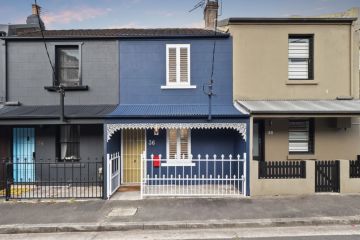Understanding Victorian planning regulations
Contemporary Deck by Matt Gibson Architecture + Design
Author: Rebecca Naughtin
Most residential developments in Australia are required to meet specific guidelines, whether through local council, building regulations, overlays or zoning laws. As designers, we are required to comply with or challenge these guidelines or policies when we apply for a planning permit or development approval. Policies directly relate to the conditions of your site, the surrounding built forms, scale, neighbourhood character and density, and how your site connects to each of these elements. The goal of these policies is to preserve the amenity of each site and that of the neighbours.
As an architect in Melbourne, I deal with these requirements on a daily basis. While each state has its own governing policies, the objectives of each state or territory are similar. This story translates the specifics of the Victorian Building Regulations and ResCode as a basis for understanding the objectives nationwide, and offers some handy solutions to build a house that suits your needs while also following the rules.
Get expert advice from a local architect
Rule 1: Thou shalt not push ahead of thy neighbour
The regulation: ‘54.03-1 Standard A3 – Minimum street setback regulation 409’
This regulation states that if there is an existing building on either side of the site being built on, and the site is not on a corner, the average distance of the setbacks should be the same as that of the front walls of the existing buildings, or 9 metres, whichever is the lesser.
If there is no existing building on either of the abutting allotments, and the site is not on a corner, the setback distance should be 6 metres for streets in a Road Zone, Category 1, and 4 metres for other streets.
Translation: Generally, the setback is the average between the two neighbouring buildings of the site. If there are no neighbouring buildings, it is 6 metres, unless stated otherwise.
The solution: While your new building may not creep forward as much as you might like, structures such as porches, verandahs, pergolas, eaves, fascias, sun blinds or screens that have a maximum height of 3.6 metres above ground level may encroach up to 2.5 metres. Or make the most of your front yard and show off your home’s facade by creating a beautiful garden.

Rule 2: Thou shalt not dominate thy neighbour
The regulation: ‘54.03-2 Standard A4 – Building height regulation 410’
According to this regulation, the maximum building height should not exceed 9 metres, unless the site slopes at any cross section wider than 8 metres of the site at 2.5 degrees or more.
In that case, the maximum building height should not exceed 10 metres. This standard also states that changes of building height between existing buildings and new buildings should be graduated.
Translation: The building height cannot exceed 9 metres, unless the building is on a slope of 2.5 degrees or more, with a property greater in width than 8 metres.
Solution: Try not to overdevelop and build under 9 metres, but if you really want to squeeze in some extra space, consider going underground with a basement level.
Rule 3: Thou shalt not be greedy
The regulation: ‘54.03-3 Standard A5 – Site coverage regulation 411’
Site coverage regulations say that the site area covered by buildings should not exceed the maximum site coverage specified in a schedule to the zone, or if no maximum site coverage is specified in a schedule to the zone, this should not exceed 60 per cent.
Translation: Simply put, you cannot occupy more than 60 per cent of your total property area. This includes roofed structures such as garages.
Solution: Make the most of your outdoor areas by creating indoor- outdoor spaces and having beautiful landscaping. This adds amenity and tranquility to your home and it’s not a bad way to get the kids out of the house as well.
Fun-filled and family-friendly backyards

Rule 4: Thou shalt not flood thy neighbour
The regulation: ‘54.03-4 Standard A6 – Permeability regulation 412’
The permeability regulation specifies that the site area covered by pervious surfaces(surfaces that allow for the absorption and filtration of stormwater) should be at least the minimum area specified in a schedule to the zone; or if no minimum area is specified in a schedule to the zone, 20 per cent of the site.
Translation: Another simple one; at least 20 per cent of your property must remain permeable.
Solution: Consider using permeable tiling, driveways, decking and, of course, landscaping as in the image above. This helps retain water and stops stormwater run-off, which can lead to blockages and pollution of our oceans.

Rule 5: Thou shalt not waste energy
The regulation: ‘54.03-5 Standard A7 – Energy efficiency regulation’
In this standard, we are advised that buildings should be oriented to make appropriate use of solar energy. The regulation also states that buildings should besited and designed to ensure that the energy efficiency of existing dwellings on adjoining lots is not unreasonably reduced.
Translation: Your design must make use of passive solar techniques, reducing electricity costs, and should not impact on the energy efficiency of neighbouring properties.
Solution: Orientate your windows towards the north, as well as locating shared spaces such as living and lounge rooms towards northern windows. Bathrooms, ensuites, walk-in robes and similar rooms should be located towards the south.
Rule 6: Thou shalt not destroy worthy nature
The regulation: ‘54.03-6 Standard A8 – Significant trees regulations’
This section of the legislation tells homeowners that development should provide for the retention or planting of trees, where these are part of the neighbourhood character. In addition, we are advised that development should provide for the replacement of any significant trees that have been removed in the 12 months prior to the application being made.
Translation: If large or significant trees are located on your property you must retain them, or replace them if they need to be removed. It’s often best to get an arborist if you suspect you have a significant tree within your property. Also note that permission is often needed to remove trees, so get in contact with your local council if in doubt. Heavy fines can apply if you don’t.
Solution: Build your home around existing trees, creating unique geometry and moments within the design.
Trees incorporated into home designs

Rule 7: Thou shalt not overdevelop
The regulation: ‘54.04-1 Standard A10 – Side and rear setbacks regulation 414’
Side and rear setback regulations require a new building not on or within 200 millimetres of a boundary to be set back from side or rear boundaries at least 1 metre, plus 0.3 metres for every metre of height over 3.6 metres up to 6.9 metres, plus 1 metre for every metre of height over 6.9 metres.
Translation: Think of a wedding cake. Every time you add an extra level, the piece on top gets smaller and smaller. Similarly with buildings, as it grows taller it must get narrower and have larger setbacks from the boundary.
Solution: Don’t let this hinder your design opportunities. Instead allow this to help articulate the form of your building, maximising the usable amount of space within your home. Also, some elements such as verandahs, gutters and chimneys, may encroach up to 0.5 metres more.
Rule 8: Thou shalt not brick out thy neighbour
The regulation: ‘54.04-2 Standard A11 – Walls on boundary regulation 415’
This regulation states that a new wall constructed on or within 200 millimetres of a side or rear boundary of a lot should not abut the boundary for a length of more than 10 metres, plus 25 per cent of the remaining length of the boundary of an adjoining lot.
Or, where there are existing walls against the boundary on an abutting lot, walls should not exceed the length of the existing structures, whichever is the greater.
Translation: You can only build a certain length of wall along a boundary of your property. The length is calculated based on the perimeter of your property boundaries. The walls must have a maximum height of 3.6 metres and be a maximum length of 25 per cent of the boundary wall length, plus 10 metres.
Solution: Have your walls step in every now and again, creating little courtyards. This not only reduces your boundary wall length, it also allows more light into a home.

Rule 9: Thou shalt not steal thy neighbour’s daylight
The regulation: ‘54.04-3 Standard A12 – Daylight to existing windows regulation 416’
This standard states that buildings opposite an existing habitable room window shouldprovide for a light court to the existing window that has a minimum area of 3 square metres and minimum dimension of 1 metre clear to the sky.
It also states that walls or carports more than 3 metres in height opposite an existing habitable room window should be set back from the window at least 50 per cent of the height of the new wall, if the wall is within a 55 degree arc from the centre of the existing window.
Translation: You need to allow light into your neighbour’s existing windows. In order to do this, you must provide a minimum area of 3 metres square with 1 metre clear to the sky around your neighbour’s window. This area can be calculated from either yours or your neighbour’s property.
Solution: Create courtyard and garden spaces similar to the standard before. This will allow light not only into your neighbour’s windows but also into your own.
Find window professionals in your area
Rule 10: Thou shalt protect the energy efficiency of thy neighbours
The regulation: ‘54.04-4 Standard A13 – North facing windows regulation 417’
Here, we are told that if a north-facing habitable room window of an existing dwelling is within 3 metres of a boundary on an abutting lot, a building should be set back from the boundary 1 metre, plus 0.6 metre for every metre of height over 3.6 metres up to 6.9 metres, plus 1 metre for every metre of height over 6.9 metres, for a distance of 3 metres from the edge of each side of the window.
Translation: You need to preserve your neighbour’s northern sun and if their window is within 3 metres of the boundary, you must set back your building 1 metre plus 0.6 metres for every metre higher than 3.6 metres. This continues until 6.9 metres – every metre after that, you must set back your house another metre.
Solution: Note where your neighbour’s north-facing windows are before you design your building, so that you can plan around them early rather than getting nasty shocks later during the planning process.
Rule 11: Though shalt not keep thy neighbours in the dark
The regulation: ‘54.04-5 Standard A14 – Overshadowing regulation 418’
This regulation advises that where sunlight to the secluded private open space of an existing neighbouring dwelling is reduced, at least 75 per cent – or 40 square metres with minimum dimension of 3 metres – whichever is the lesser area, of the secluded private open space should receive a minimum of five hours of sunlight between 9am and 3pm on 22 September.
Translation: You must preserve the sunlight in your neighbour’s private open space, allowing for at least five hours of light within the hours of 9am and 3pm on the vernal (spring) equinox – when the hours of night and day are equal.
Solution: The good thing about this standard is if you’ve already set back your building in accordance with the other standards, you shouldn’t overshadow your neighbour’s property much. Although if you are stepping back with terraces, this is a great way to drastically reduce your shadow footprint.
Rule 12: Thou shalt not perv on thy neighbours
The regulation: ‘54.04-6 Standard A15 – Overlooking regulation 419’
Overlooking regulations say that a habitable room window, balcony, terrace, deck or patio should be located and designed to avoid direct views into the secluded private open space and habitable room windows of an existing dwelling, within a horizontal distance of 9 metres. Views should be measured within a 45-degree angle from the plane of the window, and from a height of 1.7 metres above floor level.
Translation: Windows within 9 metres cannot directly look into adjacent property windows that contain habitable rooms or onto secluded private open space.
Solution: No need to avert your eyes from sunbathing neighbours. Simply install fixed screens with a maximum of 25 per cent open area. Or use frosted windows that are 75 per cent opaque, or simply build windows that start at 1.7 metres high, often useful for bathrooms.
Rule 13: Thou shalt receive adequate light
The regulation: ‘54.05-1 Standard A16 – Daylight to new windows regulation 420’
Here homeowners are advised that a window in a habitable room should be located to face an outdoor space clear to the sky or a light court with a minimum area of 3 square metres and minimum dimension of 1 metre clear to the sky.
Translation: Your windows must face an open area of 3 square metres, with 1 metre clear to the sky to allow adequate light.
Solution: Like the example image, consider smart window locations such as roof lights. In addition, consider placement of verandahs and eaves to allow light in during the winter months yet block the summer sun. This can be achieved through using the angles of the sun. As well as this, consider light courts as suggested before for other solutions.
Passive solar design for the home
Rule 14: Thou shalt enjoy the great outdoors
The regulation: ‘54.05-2 Standard A17 – Private open space regulation 421’
This regulation states that a dwelling should have private open space consisting of an area of 80 square metres, or 20 per cent of the area of the lot, whichever is the lesser, but not less than 40 square metres.
Translation: 20 per cent of the property area must be private open space or 80 square metres, whichever is lesser. The minimum amount required is 40 square metres, regardless of property size.
Solution: As our urban areas become denser, it’s harder to keep private open space, but maybe consider a green roof. It will not only create a beautiful space, but will also counter the urban heat island effect. If you’re not too much of a fan of the green, try a secluded roof deck.
Rule 15: Thou shalt go north
The regulation: ‘54.05-3 Standard A18 – Solar access to open space regulation’
We are advised in this section of the legislation that the private open space of a residential property should be located on the north side of the dwelling, if possible. It also states that the southern boundary of secluded private open space should be set back from any wall on the north of the space at least (2 + 0.9h) metres, where ‘h’ is the height of the wall.
Translation: Try building your outdoor spaces towards the north. If you can’t, they need to be set back 2 metres plus 0.9 metres for every metre in height.
Solution: Prioritise sunlight within the design of your home. It will be nicer to live in and you’ll save money on energy bills.
Rule 16: Thou shalt detail thy home
The regulation: ‘54.05-4 Standard A19 – Design detail regulation’
Here the regulations state that designers, builders and homeowners are to encourage design detail on the facade of a residential dwelling that respects the existing or preferred neighbourhood character.
Translation: One of the broader regulations, this stipulates that your home should include facade articulation, designed window and door proportions, roof form and detailing of verandahs, eaves and parapets.
Solution: Ensure your design has elements of detail. This extra level of articulation will make your home more unique and add an extra layer of design integrity. Just think of those beautiful old Victorian terraces.
Rule 17: Thou shalt provide security without gating thy community
The regulation: ‘54.05-5 Standard A20 – Front fence regulations’
Finally, this section of the legislation states that a front fence within 3 metres of a street should not exceed 2 metres in road zone category 1 … 1.5 metres in other streets.
Translation: A very simple one. Fences must either be a maximum of 1.5 to 2 metres, depending on what type of street you live in.
Solution: Keep your fence height similar to others in the street and don’t exceed the specified height. This doesn’t mean you can’t have any fun. Try mixing up the design of your fence with different layers of porosity, allowing some of your garden vegetation to show through, while still providing you with privacy.
We recommend
States
Capital Cities
Capital Cities - Rentals
Popular Areas
Allhomes
More
- © 2025, CoStar Group Inc.







